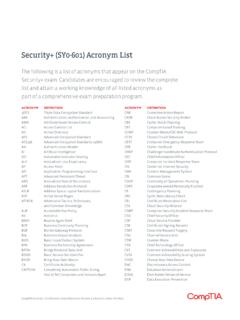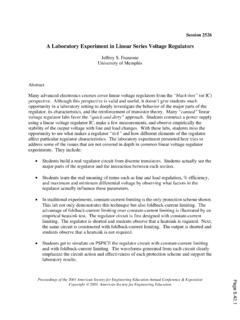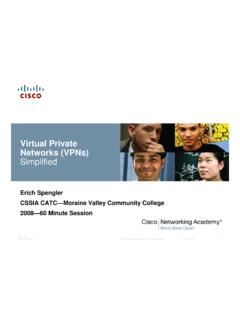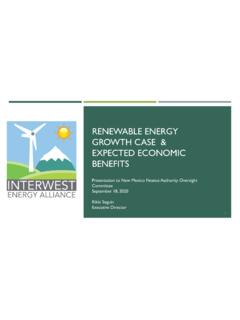Transcription of An Overview of Renewable Natural Gas from Biogas
1 AN Overview OF Renewable Natural GAS FROM Biogas July 2020 EPA 456-R-20-001 i Table of Contents INTRODUCTION .. 1 WHAT IS RNG? .. 1 Sources of 1 OPTIONS FOR RNG DELIVERY AND 5 Pipeline Injection .. 6 Local Use .. 7 BENEFITS OF RNG .. 8 Fuel Diversity and Availability .. 8 Local Economic Impacts .. 8 Local Air Quality .. 9 GHG Emission Reductions .. 11 Other Benefits of Natural Gas Vehicles .. 13 OPERATIONAL RNG PROJECTS .. 14 CONSIDERATIONS FOR PROJECT FEASIBILITY AND POTENTIAL FOR GROWTH .. 16 PURIFICATION PROCESSES AND GENERAL TECHNOLOGIES .. 20 CO2 Removal Technologies .. 21 VOC/Siloxane Removal Technologies .. 24 N2 Removal Technologies .. 25 O2 Removal Technologies .. 26 The Future of RNG Processing Technologies .. 26 Reliable Power Sources for Advanced 27 Compressing RNG.
2 27 BARRIERS, POLICY DRIVERS AND INCENTIVES RELATED TO RNG PROJECT DEVELOPMENT .. 27 Economic Barriers .. 28 Technical Barriers .. 29 Perception of RNG Quality .. 30 Policies and Incentives Related to Pipeline Injection .. 30 Policies and Incentives Related to Use of RNG as Transportation 33 State Regulatory Policies and Incentives Related to Electricity .. 34 Policies and Incentives Related to Sustainability and Environmental Goals .. 35 38 RNG Projects with Feedstock, Delivery Method and End Use .. 38 ii Corporate Alternative Fuel Fleets .. 44 RESOURCES .. 45 ABBREVIATIONS, ACRONYMS AND UNITS OF MEASURE .. 46 Appendix A: Natural Gas Companies Accepting RNG into iii List of Tables Table 1. AFLEET Tool Emission Results for Replacement of Washington, Older Model Year Gasoline Pickups or Diesel Refuse Trucks with New (Model Year 2019) Dedicated CNG Pickups or Refuse Trucks.
3 10 Table 2. CI Ranges of Fossil and Renewable Vehicle Fuels from CARB LCFS-Certified Pathways .. 12 Table 3. Breakdown of LFG-to-RNG Project Types and Sizes in the United States from the LMOP Landfill and LFG Energy Project Database .. 15 Table 4. WRRF Digester Gas-to-RNG Projects Operating in the United States in 2019 .. 15 Table 5. Number of Biogas Utilization Projects for Varying WRRF Capacities .. 18 Table 6. Typical Flow Rates for Advanced CO2 Removal Technologies .. 24 List of Figures Figure 1. Organic Waste Types Used to Make RNG .. 2 Figure 2. LFG Treatment Stages and Biogas End Uses .. 3 Figure 3. AD Products, Biogas Treatment and End Uses .. 4 Figure 4. RNG Delivery Options and Typical RNG End 5 Figure 5. Components of a Pipeline Interconnection .. 6 Figure 6. Example CIs from LFG-RNG-CNG Life Cycle (g CO2e/MJ).
4 13 Figure 7. CO2 Removal Technologies for LFG-to-RNG Projects in 22 Figure 8. CO2 Removal Technologies for Manure-Based Biogas -to-RNG Projects in 22 Figure 9. Breakdown of RNG Processing and Interconnection Costs .. 31 1 INTRODUCTION EPA encourages the recovery and beneficial use of Biogas as a Renewable energy resource, including the production of Renewable Natural gas (RNG) when feasible, as a means of reducing emissions and providing other environmental benefits. RNG is a term used to describe Biogas that has been upgraded to use in place of fossil Natural gas, either locally or remotely. EPA s partnership programs for the reduction of methane (CH4) emissions the Landfill Methane Outreach Program (LMOP), AgSTAR and Natural Gas STAR offer data on potential sources of RNG feedstocks as well as technical and outreach resources and tools to support RNG project development.
5 EPA developed this document to provide Biogas stakeholders and other interested parties with a resource to promote and potentially assist in the development of RNG projects. This document summarizes existing RNG operational projects in the United States and the potential for growth from the main sources of Biogas feedstock. This document provides technical information on how raw Biogas is upgraded into RNG and ultimately delivered and used by consumers. The document also addresses barriers, policies and incentives related to RNG project development. WHAT IS RNG? RNG is a term used to describe anaerobically-generated Biogas that has been upgraded (or refined) for use in place of fossil Natural gas. Raw Biogas typically has a CH4 content between 45 and 65 percent, depending on the source of the Biogas , and must go through a series of steps to be converted into RNG.
6 Treatment includes removing moisture, carbon dioxide (CO2) and trace-level contaminants (including siloxanes, volatile organic compounds [VOCs] and hydrogen sulfide [H2S] ), as well as reducing the nitrogen (N2) and oxygen (O2) content. Once purified, the RNG has a CH4 content of 90 percent or greater. RNG injected into a Natural gas pipeline commonly has a CH4 content between 96 and 98 percent. As a substitute for fossil Natural gas, RNG has many potential uses. RNG can be used as vehicle fuel, to generate electricity, in thermal applications, or as a bio-product feedstock. RNG can be injected into Natural gas transmission or distribution pipelines, or it can be used locally ( , at or near the site where the gas is created). In this document, the term RNG does not encompass synthesis gas (syngas) produced through gasification of biomass or any other feedstocks.
7 Sources of RNG Currently, there are four main sources of Biogas used to produce RNG in the United States: municipal solid waste (MSW) landfills, anaerobic digestion (AD) at municipal water resource recovery facilities (WRRFs), AD at livestock farms and AD at stand-alone organic waste management operations. At each of these types of operations, Biogas is produced as the organic materials are br oken down by microorganisms in the absence of O2 ( , anaerobic conditions). Figure 1 shows the main organic waste feedstocks that are placed into an MSW landfill or an AD facility. Organic in this context means the wastes come from, or were made of, plants or animals. 2 Figure 1. Organic Waste Types Used to Make RNG MSW Landfills Landfill gas (LFG) is generated in MSW landfills1 as the organic wastes decompose anaerobically.
8 Instead of escaping into the air, LFG can be captured, converted and used as an energy resource. Applicable federal and state regulations require certain landfills to capture and destroy the LFG generated; for these sites an LFG collection infrastructure is already in place and potentially ready for an energy project. The diagram in Figure 2 provides an Overview of the levels of treatment that LFG can undergo to be used as an energy resource. 1 More information about MSW landfills is available at EPA. What Is a Municipal Solid Waste Landfill? #whatis. Accessed November 18, 2019. 3 Figure 2. LFG Treatment Stages and Biogas End Uses Municipal WRRFs Many municipal WRRFs (also known as wastewater treatment facilities or publicly owned treatment works) use AD to treat sewage sludge on site, while some facilities send the sludge to other facilities for AD treatment.
9 Biogas is one of the byproducts of sludge treatment through AD. WRRFs typically generate Biogas with a high CH4 content and extremely low N2 and O2 contents, which make them attractive candidates for RNG projects. Approximately 133 to 177 WRRFs with AD were co-digesting other waste streams, such as source-separated food wastes, in Co-digestion of food waste with WRRF sludge allows facilities to use existing assets and infrastructure to meet the growing interest in food waste management. With co-digestion, facilities can more efficiently use process equipment when they process multiple waste streams together. Facilities can also use co- digestion to adjust the proportions of solids being digested to improve digestion and increase Biogas production. Livestock Farms Livestock farms can use AD to convert livestock ( , dairy, beef, swine, poultry) manure into Biogas and Some manure-based digesters co- digest other waste materials with the manure, including upstream (pre-consumer) food wastes such as beverage and distillery waste; fats, oils and greases; 2 Goldstein, N.
10 October 2017. The State of Organics Recycling in the BioCycle 58(9): 22. Accessed March 4, 2020. See Table 3 and additional discussion about data from the Water Environment & Reuse Foundation on page 6 of Goldstein s report. 3 Digestate is the nutrient-rich material left over after AD. 4 industrial food byproducts; or processing wastes from a dairy or slaughterhouse. Various sources estimate approximately 100 manure- based AD projects are co-digesting other organic waste The diagram in Figure 3 presents the Biogas and typical digestate products from manure-based AD pr ojects and the levels of treatment that AD Biogas can undergo to be used as an energy resource. Figure 3. AD Products, Biogas Treatment and End Uses Stand-Alone Organic Waste Management Operations Stand-alone digesters are the newest source of RNG in the United States.
















